Lessons of Darkness: Jacques Tourneur’s The Leopard Man

Theatrical 1-sheet for The Leopard Man
It’s axiomatic that people go to Hollywood movies in search of unsubtle thrills. The last three decades have seen the stripping away of the grace and mystery previously characterizing American commercial filmmaking at its best. The false gods Television and Internet bestride the ruins of that pagan temple complex from which once issued a stupendous, all-consuming body of work, a 20th C. Renaissance every bit the equal of the first. Instead, we are now treated to an Orgy of the Obvious, in de-sacralized space, by which our emotions are less manipulated than informed of their proper deportment, and in which every character, rather than being as guarded as necessary for survival in daily existence, reveals him or herself an open book, a puppy panting for comprehension and acceptance. Works bearing the influence of the more hifalutin’ corners of academic postmodernism often reveal a sub-variant weakness: characters as paper-doll cut-outs, programmed by social forces, cast adrift in worlds without meaning.
In 1942, Charles Koerner, production chief of RKO Pictures, assumed the reins of what until then had been a titular position. One of his first acts was to throw the Orson Welles unit (which had given the studio so much grief with its ambitious Citizen Kane and The Magnificent Ambersons) off the lot. The new company motto, “Showmanship, Not Genius” underlined the point. Soon Koerner tapped Val Lewton, an assistant to David O. Selznick, to head a new B horror-picture unit. Koerner would supply overheated, audience-tested titles – the first three were Cat People, I Walked with a Zombie, and The Leopard Man – and Lewton was charged with fabricating product to justify their lure. In assembling his unit, Lewton in turn recruited Jacques Tourneur, son of the major silent-era director, Maurice Tourneur, to direct. Val and Jacques would prove excellent bedfellows: Russian-born Val was anxiety-ridden and literary, while Jacques, who’d been brought to the US from France by his parents at the age of ten, was profoundly sensitive and attuned to the eerie; he’d later profess a belief in the supernatural forces sometimes evoked in his films. Together they cooked up a theory to inspire a connection to what had already become a hoary genre: true fear was found in the dark. Awareness of unseen presences taps into our atavistic natures, forcing our imaginations into overdrive, pushing us into the traps buried deep within our psyches. Inability to see the monster would lead to the subconscious knowledge that the monstrous lay within ourselves.
The screening by studio bosses of their initial effort, Cat People, put Lewton and Tourneur in the dog-house. Where were the creatures in this feature? Where was the red, red, red blood? A successful sneak-preview, excellent word-of-mouth and consequent box-office returns, however, fortunately dispelled all doubts – Cat People proved the sleeper of the year. Costing slightly over $140,000, the film grossed as much as $4,000,000, saving RKO from imminent bankruptcy. Lewton and Tourneur repeated their pattern of extreme low-budget/extreme success twice, with Zombie and Leopard Man, and the work of the Lewton unit began to garner a grudging respect by critics, and all-out adoration by heavyweights James Agee and Manny Farber (who compared The Leopard Man favorably to Cocteau) in the pages of The Nation and The New Republic. Nonetheless, until the publication of Chris Fujiwara’s Jacques Tourneur: The Cinema of Nightfall (surely one of the major film books of the last twenty years) in 1998, The Leopard Man had failed to receive its full critical due. Fujiwara’s brilliant extended analysis of this undervalued masterpiece illumined my love for this film, and a recent rare screening at the Pacific Film Archive, midway in a season of Lewton-produced works, has set me meditating, once again, on its dark mysteries…
Warning! – The following contains semi-spoilers:
(Unless noted otherwise, all below stills are from The Leopard Man, 1943)
The Leopard Man is set in a mostly Latin New Mexico town frequented by WASP-y tourists. Hundreds of years ago, this terrain had been the site of an Indian massacre by conquistadors, and a sect of penitent monks who found their bodies and buried them began a tradition of a yearly procession of penitence to atone for their countrymen’s mass murder. The tourists know nothing of this, however, and come in search merely for a light engagement with “local color”: 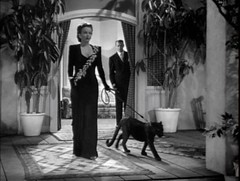
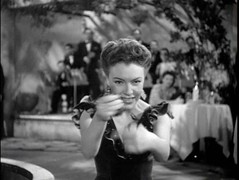 Clo-Clo (Margo), for example, a Latina dancer whose marvelous pair of castanets commands a rapt audience at the hotel nightclub. Kiki (Jean Brooks), a visiting blonde performer of some kind, can’t get a leg up in this atmosphere, so her promoter boyfriend Jerry Manning (Dennis O’Keefe) comes up with a brainwave: she’ll appear in the wings with a rented black leopard as Clo-Clo performs, and steal the show. This Kiki does in spades – every eye in the house is immediately fastened to the nervous cat prowling about her anxious figure. Cynical Clo-Clo knows just how to handle this, aggressively making towards the leopard with her flashing, clattering castanets… The terrified cat breaks free from his leash, and escapes the premises. The town is put on alert, but in one menial household a flinty mother is having no truck with such foolishness. “Have you ever seen such a creature?” she asks her young daughter, Teresa, who begs her mama not to be sent across town to fetch corn meal for making the evening’s tortillas, to no avail. On the way back, as Teresa makes her way through a dark railroad underpass, she looks up to see a pair of huge feline eyes glowering at her in the darkness… Back at the house,
Clo-Clo (Margo), for example, a Latina dancer whose marvelous pair of castanets commands a rapt audience at the hotel nightclub. Kiki (Jean Brooks), a visiting blonde performer of some kind, can’t get a leg up in this atmosphere, so her promoter boyfriend Jerry Manning (Dennis O’Keefe) comes up with a brainwave: she’ll appear in the wings with a rented black leopard as Clo-Clo performs, and steal the show. This Kiki does in spades – every eye in the house is immediately fastened to the nervous cat prowling about her anxious figure. Cynical Clo-Clo knows just how to handle this, aggressively making towards the leopard with her flashing, clattering castanets… The terrified cat breaks free from his leash, and escapes the premises. The town is put on alert, but in one menial household a flinty mother is having no truck with such foolishness. “Have you ever seen such a creature?” she asks her young daughter, Teresa, who begs her mama not to be sent across town to fetch corn meal for making the evening’s tortillas, to no avail. On the way back, as Teresa makes her way through a dark railroad underpass, she looks up to see a pair of huge feline eyes glowering at her in the darkness… Back at the house, 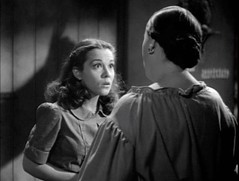
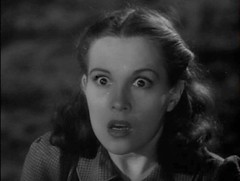
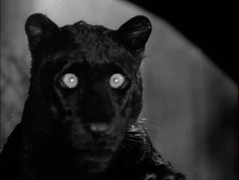 Teresa’s return is greeted caustically. “Mamacita! Let me in! MAMACITA!!” She is refused. Only when the sounds of a predatory beast joins her daughter’s shrieks does the woman and her wiseacre son attempt to open the door’s stuck lock. Too late. They look down to see poor Teresa’s blood seeping under the door towards their feet.• In the next day or two, the beautiful young heiress Consuelo meets with a similar end at the cemetery to which she’s gone to meet her lover, and later, it’s the arrogant, glamorous Clo-Clo who will meet her fate… As the carnage mounts, a guilt-ridden Jerry and Kiki begin to suspect the leopard could only have performed the first killing, that the others must be homicide. But what evil forces could compel a human to such acts? Earlier in the film, an expert in cat and human psychology with whom Jerry has struck an acquaintance turns and points to a plastic ball kept suspended in air by a fountain’s spout, saying “We know as little about the forces that move us, and move the world around us, as that empty ball does about the water that pushes it into the air, lets it fall, and catches it again…”
Teresa’s return is greeted caustically. “Mamacita! Let me in! MAMACITA!!” She is refused. Only when the sounds of a predatory beast joins her daughter’s shrieks does the woman and her wiseacre son attempt to open the door’s stuck lock. Too late. They look down to see poor Teresa’s blood seeping under the door towards their feet.• In the next day or two, the beautiful young heiress Consuelo meets with a similar end at the cemetery to which she’s gone to meet her lover, and later, it’s the arrogant, glamorous Clo-Clo who will meet her fate… As the carnage mounts, a guilt-ridden Jerry and Kiki begin to suspect the leopard could only have performed the first killing, that the others must be homicide. But what evil forces could compel a human to such acts? Earlier in the film, an expert in cat and human psychology with whom Jerry has struck an acquaintance turns and points to a plastic ball kept suspended in air by a fountain’s spout, saying “We know as little about the forces that move us, and move the world around us, as that empty ball does about the water that pushes it into the air, lets it fall, and catches it again…”
The multi-character and semi-fractured narrative stylistics of The Leopard Man point to a manner of European Art cinema shortly to develop in the withdrawing tide of WWII, beginning with Rome, Open City. These indicate a perhaps subconscious desire to create a capsule universe which could come to terms with the greatest conflagration in human history, then currently raging. Tourneur’s film is suffused by a self-aware tension between Good and Evil as reflected in its characters and their circumstances: the palpable humanity of these people is butted up against examples of callousness, as, for example, when a kindly shopkeeper giving Teresa the corn-meal on credit (commenting humanely “The poor don’t cheat one another; we’re all poor together”) is followed by her mother’s blind denial of refuge. The generalized acknowledgment of people most often attempting to do the best they can is juxtaposed with the characters’ 
 negative attributes: female narcissism – Clo-Clo’s arrogance and incessant hunger for money, Kiki’s visceral excitement at the thought of her black dress explicitly connecting her to the black leopard’s power (“I’ll look just like him…”), Consuelo’s cloistered mother living vicariously through her spoiled daughter – is mirrored by male mental and moral complacency – Jerry’s failure to think through his ridiculous and dangerous scheme regarding the leopard, Police Chief Robles’s casual self-satisfaction and blindness to his town’s real threats – and the male psychosis of the leopard man himself. Since Fujiwara provides an excellent delineation of this micro-cosmos’s absent fathers, I’ll mention just in passing its failing mothers: Teresa’s and Consuelo’s both, in effect, send their daughters to their dooms, and the ineffectiveness of the maternal aspect is indicated by the film’s treatment of two Madonnas: one, with Child, is a statue in the cemetery unable to provide comfort to a Consuelo disconsolate at her lover’s abandonment shortly before her murder, the other
negative attributes: female narcissism – Clo-Clo’s arrogance and incessant hunger for money, Kiki’s visceral excitement at the thought of her black dress explicitly connecting her to the black leopard’s power (“I’ll look just like him…”), Consuelo’s cloistered mother living vicariously through her spoiled daughter – is mirrored by male mental and moral complacency – Jerry’s failure to think through his ridiculous and dangerous scheme regarding the leopard, Police Chief Robles’s casual self-satisfaction and blindness to his town’s real threats – and the male psychosis of the leopard man himself. Since Fujiwara provides an excellent delineation of this micro-cosmos’s absent fathers, I’ll mention just in passing its failing mothers: Teresa’s and Consuelo’s both, in effect, send their daughters to their dooms, and the ineffectiveness of the maternal aspect is indicated by the film’s treatment of two Madonnas: one, with Child, is a statue in the cemetery unable to provide comfort to a Consuelo disconsolate at her lover’s abandonment shortly before her murder, the other 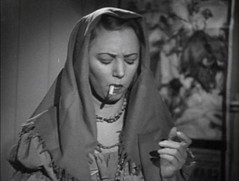
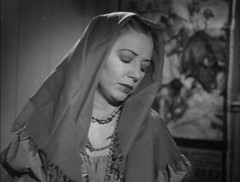 a fortune teller who, out of friendship, repeatedly attempts to dismiss the evidence from the cards of Clo-Clo’s impending demise – for a brief moment, the camera frames her in close-up, her head tilted to the side, a head covering rendering her Mother Mary’s spitting image, before her hand enters the frame, bringing a cigarette to her lips for an avid puff. These symbolic elements (even when waggish) subtly contribute to the evocation of a beautiful but disordered world, characterized by a mournful tone which grows increasingly palpable over the film’s duration, as we are led towards an encounter with the dimension of the sacred.
a fortune teller who, out of friendship, repeatedly attempts to dismiss the evidence from the cards of Clo-Clo’s impending demise – for a brief moment, the camera frames her in close-up, her head tilted to the side, a head covering rendering her Mother Mary’s spitting image, before her hand enters the frame, bringing a cigarette to her lips for an avid puff. These symbolic elements (even when waggish) subtly contribute to the evocation of a beautiful but disordered world, characterized by a mournful tone which grows increasingly palpable over the film’s duration, as we are led towards an encounter with the dimension of the sacred.
The climax of The Leopard Man finds Jerry, Kiki, and Consuelo’s lover, Raoul, in hot pursuit of the film’s eponymous Man of mystery on the night of the penitent’s annual procession. After helping to flush him from his lair, Kiki is left behind (this is men’s business) as Jerry and Raoul follow the Man as he attempts to blend in with the slowly marching 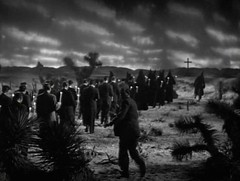 penitents. The Man has explained the procession’s import to a pretty blonde passerby shortly before, so the weight of this ceremony is very much present in the mind of the viewer. It’s a striking night, stunningly captured by Robert De Grasse’s noir-inflected cinematography. The penitents, in cone-hooded black cowls, and carrying long white candles (“What gives with those crazy Klu Klux-ers?” asks a character in Welles’ Mr. Arkadin [1955] upon spying a similar procession, in this case an authentic one in Spain; Tourneur deals explicitly with the Klan in Stars in My Crown, [1950]), are set against a black sky adorned by bright white clouds. As Jerry and Raoul catch up to the Man in line and urge him to confess, the threnodial chanting of the penitents viscerally cues us to our having entered
penitents. The Man has explained the procession’s import to a pretty blonde passerby shortly before, so the weight of this ceremony is very much present in the mind of the viewer. It’s a striking night, stunningly captured by Robert De Grasse’s noir-inflected cinematography. The penitents, in cone-hooded black cowls, and carrying long white candles (“What gives with those crazy Klu Klux-ers?” asks a character in Welles’ Mr. Arkadin [1955] upon spying a similar procession, in this case an authentic one in Spain; Tourneur deals explicitly with the Klan in Stars in My Crown, [1950]), are set against a black sky adorned by bright white clouds. As Jerry and Raoul catch up to the Man in line and urge him to confess, the threnodial chanting of the penitents viscerally cues us to our having entered  a sacral moment. The specific evils dealt with in the film are, via this scene, and its allusion to the Indian massacre hundreds of years ago, linked to the most ancient human atrocities of the most distant, even primordial, past. The layering of anthropological/historical allusion is extremely dense – a Christianity which has covered over paganism and nature, producing a compacted, agonizing complex of blood lust, the compulsion to propitiate the hungry god(s) of paganism and the Old Testament, and the blood guilt occasioned by the Fall of Man in Christianity. Leopard Man‘s climax evokes a sacred tragedy of dark compulsions of the collective human psyche which must be borne in resolved penitence until scapegoats are found and sacrificed (etymology of “sacrifice”: “to make holy”), which happens five times over the course of the film – to the three female victims, and to their killers, cat and man – and which was occurring, as the film was shot and released, in en masse spasms of the most hideous violence the world has ever known, all over the globe. No wonder a film characterized by lyricism and the elegiac was such a hit.
a sacral moment. The specific evils dealt with in the film are, via this scene, and its allusion to the Indian massacre hundreds of years ago, linked to the most ancient human atrocities of the most distant, even primordial, past. The layering of anthropological/historical allusion is extremely dense – a Christianity which has covered over paganism and nature, producing a compacted, agonizing complex of blood lust, the compulsion to propitiate the hungry god(s) of paganism and the Old Testament, and the blood guilt occasioned by the Fall of Man in Christianity. Leopard Man‘s climax evokes a sacred tragedy of dark compulsions of the collective human psyche which must be borne in resolved penitence until scapegoats are found and sacrificed (etymology of “sacrifice”: “to make holy”), which happens five times over the course of the film – to the three female victims, and to their killers, cat and man – and which was occurring, as the film was shot and released, in en masse spasms of the most hideous violence the world has ever known, all over the globe. No wonder a film characterized by lyricism and the elegiac was such a hit.

Jacques Tourneur
Before The Leopard Man was even released, Tourneur was reassigned by RKO to their A unit – the execs figured they could double their good fortune by splitting up these two hit-makers. The Lewton unit never recovered – none of this literate and ambitious producer’s other films came even remotely close to the sublimities of his collaborations with Tourneur. Both men regretted the split. Tourneur’s last major film, Curse of the Demon, was a throwback to his Lewton work, coming close in quality and tone to those early achievements. In between, he produced arguably the most undervalued body of work in American cinema, with such major works or masterpieces as Experiment Perilous, Easy Living, Stars in My Crown, Canyon Passage and Great Day in the Morning (the latter two both westerns), and two films noir, Nightfall and Out of the Past. This last film is generally considered among the top half dozen or so of this brilliantly murky cinematic domain, and is probably the Tourneur work par excellence. Like his work with Lewton, Out of the Past, with its “impassive” performance by Jane Greer, heads straight to the thematic territory in which Tourneur was most at home: the ultimately unfathomable nature of human psyche and soul. None of his post-Lewton works, however, quite hit their quality of Dionysian terror and violence. Not for nothing had the young Tourneur combed the volumes of Freud, Adler, and Jung in his father’s library: these Lewton B movies were clearly impacted by the three psychologists’ themes of sex, power, and the sacred. Fujiwara claims “a therapeutic, redemptive power” for The Leopard Man. Tourneur explains his Lewton work connecting with audiences being due to “war psychosis… In wartime people want to be frightened…” Elsewhere he said “we all carry in us a feeling of guilt. Cruelty flows in our blood, even if we have learned to master it.” Wartime audiences might also have resonated with the philosophy embedded within The Leopard Man‘s confrontation with the dark side of Self: “We know as little about the forces that move us, and move the world around us, as that empty ball does about the water that pushes it into the air, lets it fall, and catches it again…” Amidst the paroxysms of WWII, who could argue?

• William Friedkin identifies this image as the source of a similar one serving as a major element in the plot and symbolism of Gabriel García Márquez’s One Hundred Years of Solitude, remembered from his days as a film critic for El Espectador. He is said to love American genre films, and might have been taken with Tourneur’s sensitive treatment of Leopard Man‘s Latin characters. The attitude within his oeuvre towards its minority characters in general leads Fujiwara to describe Tourneur’s work as “deeply anti-racist”.